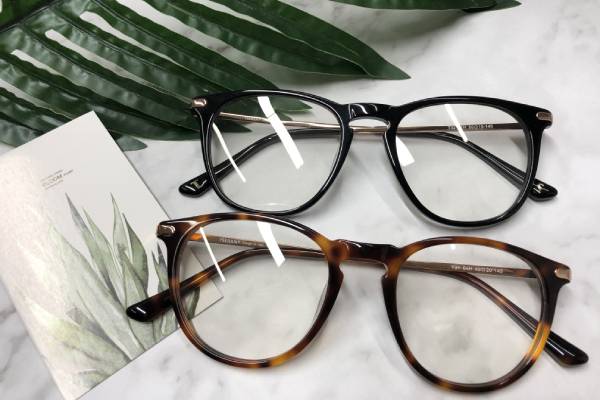The best frame is the one that suits you.
You can choose the full-frame, because the edge of the lens is relatively thick, which can block the thickness of the edge, so it is suitable for high myopia to choose. They can choose a smaller frame. The size of the eyeglass frame should match the pupil distance so that the edge thickness of the lens is thinner and they are more comfortable to wear. The size of the frame should be proportional to the size of the face. The upper edge of the frame should not be higher than the eyebrow and the eyebrow should not be visible in the lenses. The shape of the frame should match the face shape and skin tone to meet aesthetic requirements. Everyone's face size is different, so the smaller the frame is, the better, based on what fits you and what you like.
Polygonal eyeglasses
Polygonal eyeglasses are a popular trend in recent years, showing the strong self of the personality trend and an interesting personality. Because the shape is unique, unlike ordinary square glasses frame, it can subtly shift the focus, so that the face is more perfect, very suitable for the confident man who can calmly face other people's eyes. Basically, the geometric frame is a stylish and versatile one. Men with small, wide eyes are particularly recommended to try this playful frame to create a larger, narrower eye distance effect.
Glasses are frequently replaced.
In the United States today, there are more glasses than people. Counting prescription glasses, sunglasses, and over-the-counter readers, there are now more than 400 million pairs on the market. According to the Vision Council, an industry group, they swap out a brand new pair of glasses every two years on average.
The price of new lenses
The price of the new lenses depends on several factors, including if you have vision insurance. Another aspect to think about is that if your lenses need an anti-glare solution. If so, the lenses may be much more expensive. If you need eye exams and special lenses, the cost can be quite high. Scratched lenses are easier to repair. If you want your scratched lenses repaired by a professional, most opticians can pay very little.
Difference Between Driving Glasses And Night Vision Goggles
Polarized glasses are made according to the principle of the polarization of light. Night vision goggles are an auxiliary observation tool based on night vision technology with the help of photoelectric imagers. Driving glasses are made according to the lens polarized angle and radian, on the basis of the principle of precision optical design. They can only make good light pass through, and other light sources, like the strong sunlight, the glare of a light source like a car headlight is filtered, thus removing the interference of external light, to avoid the presbyopia, dazzling, and so on. Night-vision goggles are divided into two kinds: One is Night Goggles, and the other one is Thermal Goggles. Image intensifying night vision technology is a photoelectric imaging technology that enhances the faint target image illuminated by night skylight through night-vision goggles with an intensifier tube for observation.
What Are Progressive Lenses?
Progressive lenses also called multifocal lenses, have three prescriptions in one pair of glasses, which allows you to see near, middle-distance, and far objects without changing your glasses.
The traditional glasses have telltale lines in the lenses, while the progressive lenses are an update on bifocal and trifocal lenses. Progressive lenses have a seamless look. Sometimes, they are called no-line bifocals. The more accurate name is no-line trifocals.
Progressive lenses are typically designed for people over 40 years old who are both nearsighted and farsighted. With the progressive lenses, there is no need for you to change the nearsightedness eyeglasses and the farsightedness eyeglasses constantly.
Is blue light blocking worth it?
There are two main problems with anti-blue glasses currently on the market. One is that the place to be prevented is not preventable, and the other is that people have color casts due to wrong protection and aggravate visual fatigue. Studies have shown that our eyes are the most intolerant of blue light in the 400-440 nanometer band. Therefore, current manufacturers mainly block blue light in this band when producing anti-blue glasses. However, the blue waveband of electronic products is between 450 nanometers and 490 nanometers, so most anti-blue glasses have little protection in this waveband. In addition, the blocking rate of anti-blue glasses is 20%~30% to achieve a good anti-blue light effect, but now the blocking rate of anti-blue glasses on the market has basically reached 80%~90%. All in all, these blocking blue light glasses cannot prevent the blue light in the 450-490 nanometer band, and their high blocking rate will also cause a color shift, which makes people more likely to have eye fatigue and headache.
In daily life, the intensity of blue light is low, not enough to cause damage to the fundus, so ordinary people do not need to wear anti-blue glasses unless they are working in extremely strong light conditions or working in special environments. To protect the eyes, it is more important for people to develop good eye habits. For example, wear a pair of suitable glasses and read insufficient light and at an appropriate distance. Avoid using electronic products for a long time. Take a break for 20 to 30 seconds every 20 to 30 minutes, and look at the distance regularly. If you have dry eyes while reading the electronic screen, remember to blink to 12 times per minute. It is best to wear sunglasses when outdoors.











































